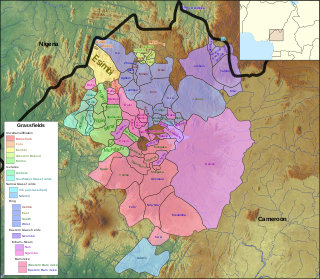Related Research Articles
In phonetics, palatalization or palatization is a way of pronouncing a consonant in which part of the tongue is moved close to the hard palate. Consonants pronounced this way are said to be palatalized and are transcribed in the International Phonetic Alphabet by affixing the letter ⟨ʲ⟩ to the base consonant. Palatalization cannot minimally distinguish words in most dialects of English, but it may do so in languages such as Russian, Japanese, Norwegian (dialects), Võro, Irish and Kashmiri.

Sandawe is a language spoken by about 60,000 Sandawe people in the Dodoma Region of Tanzania. Sandawe's use of click consonants, a rare feature shared with only two other languages of East Africa – Hadza and Dahalo, had been the basis of its classification as a member of the defunct Khoisan family of Southern Africa since Albert Drexel in the 1920s. Recent investigations however suggest that Sandawe may be related to the Khoe family regardless of the validity of Khoisan as a whole. A discussion of Sandawe's linguistic classification can be found in Sands (1998).
The phonology of Japanese features a phonemic inventory of five vowels and 15 or more consonants. The phonotactics are relatively simple, allowing for few consonant clusters. Japanese phonology has been affected by the presence of several layers of vocabulary in the language: in addition to native Japanese vocabulary, Japanese has a large amount of Chinese-based vocabulary and loanwords from other languages.
In phonetics, secondary articulation occurs when the articulation of a consonant is equivalent to the combined articulations of two or three simpler consonants, at least one of which is an approximant. The secondary articulation of such co-articulated consonants is the approximant-like articulation. It "colors" the primary articulation rather than obscuring it. Maledo (2011) defines secondary articulation as the superimposition of lesser stricture upon a primary articulation.
This article deals with the phonology of the standard Ukrainian language.
The phonological system of the Polish language is similar in many ways to those of other Slavic languages, although there are some characteristic features found in only a few other languages of the family, such as contrasting postalveolar and alveolo-palatal fricatives and affricates. The vowel system is relatively simple, with just six oral monophthongs and arguably two nasals in traditional speech, while the consonant system is much more complex.
The Yele language, or Yélî Dnye, is the language of Rossel Island, the easternmost island in the Louisiade Archipelago off the eastern tip of Papua New Guinea. There were some 4,000 speakers in 1998, comprising the entire ethnic population. The language remains unclassified by linguists.
The phonology of Sesotho and those of the other Sotho–Tswana languages are radically different from those of "older" or more "stereotypical" Bantu languages. Modern Sesotho in particular has very mixed origins inheriting many words and idioms from non-Sotho–Tswana languages.
Kemezung is a Southern Bantoid language of Cameroon. According to Ethnologue, it's 85% lexically similar to Bebe.
Izi is an Igboid language spoken in Ebonyi state in Nigeria. It forms a dialect cluster with the closely related languages Ikwo, Ezza, and Mgbo.
Lithuanian has eleven vowels and 45 consonants, including 22 pairs of consonants distinguished by the presence or absence of palatalization. Most vowels come in pairs which are differentiated through length and degree of centralization.
This article discusses the phonological system of the Bulgarian language.
Wahgi is a Trans–New Guinea language of the Chimbu–Wahgi branch spoken by approximately 100,000 people in the highlands of Papua New Guinea. Like other Chimbu languages, Wahgi has some unusual lateral consonants.
This article discusses the phonological system of standard Russian based on the Moscow dialect. For an overview of dialects in the Russian language, see Russian dialects. Most descriptions of Russian describe it as having five vowel phonemes, though there is some dispute over whether a sixth vowel,, is separate from. Russian has 34 consonants, which can be divided into two types:
Maring, also known as Mareng or Yoadabe-Watoare, is a Trans–New Guinea language of the Chimbu–Wahgi branch. Speakers of the language can be found in the Bismarck range of the Madang province or in the Hagen district of the Western Highlands province. Dialects of the Maring language are Central Maring, Eastern Maring, Timbunki, Tsuwenki, Karamba, and Kambegl. All Maring speakers can understand the Central Maring dialect.
Jibu is a Jukunoid language spoken in the Taraba State of Nigeria by 30,000 people.
Yɛmba or Yemba, also Yémba or Bamiléké Dschang, is a major Bamileke language of Cameroon. It was spoken by 300,000 or so people in the West Region in 1992.

Babanki, or Kejom, is a Bantoid language that is spoken by the Babanki people of the Western Highlands of Cameroon.
Mengen and Poeng are rather divergent dialects of an Austronesian language of New Britain in Papua New Guinea.
Luang, also known as Literi Lagona, is an Austronesian language spoken in the Leti Islands and the Babar Islands in Maluku, Indonesia. It is closely related to the neighboring Leti language, with 89% shared basic vocabulary.
References
- ↑ Gungu at Ethnologue (18th ed., 2015) (subscription required)
- ↑ Jouni Filip Maho, 2009. New Updated Guthrie List Online
- ↑ Casali & Diprose 2007.
- 1 2 3 Moe & Mbabazi 2008.
- ↑ Moe & Mbabazi 2008, p. 27.
Works cited
- Casali, Rod; Diprose, Martin (2007). Lugungu Phonology Statement (PDF). SIL International. Archived from the original (PDF) on 2022-01-21.
- Moe, Ronald; Mbabazi, James (May 2008). Lugungu orthography guide (2nd ed.). SIL. OCLC 555770294.
- Robert, Businge Makolome; Diprose, Martin (2016). "The Lugungu Alphabet". Lugungu Dictionary.